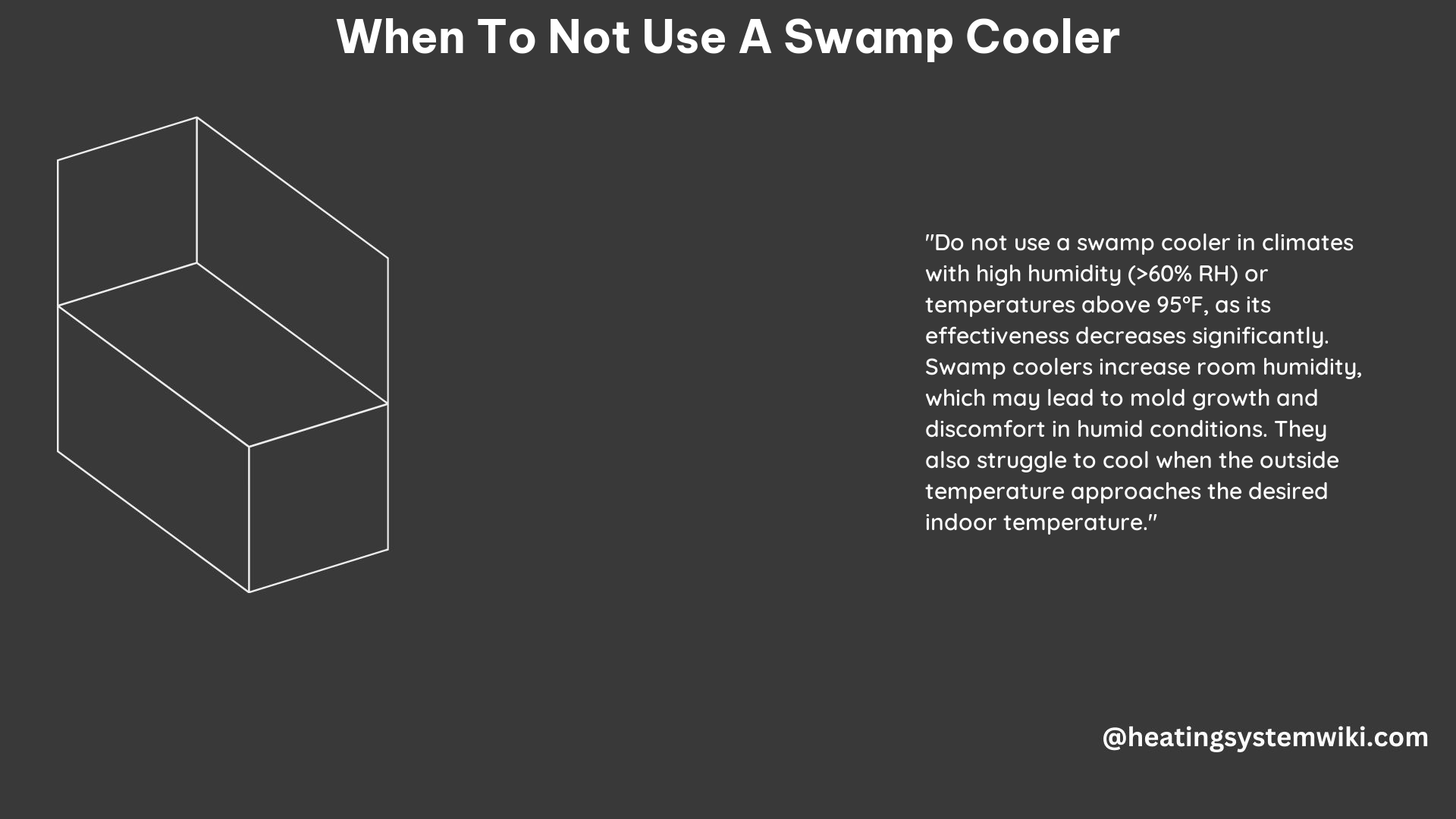Swamp coolers, also known as evaporative coolers, are a popular and cost-effective cooling solution in many regions with dry climates. However, there are specific situations where using a swamp cooler may not be the best choice. This comprehensive guide will explore the technical details and factors to consider when deciding whether a swamp cooler is the right cooling option for your home or business.
High Humidity: The Kryptonite of Swamp Coolers
Swamp coolers rely on the principle of evaporative cooling, where the air is cooled as water evaporates. This process is highly effective in dry climates, but it becomes less efficient as the air becomes more saturated with moisture. In areas with high humidity, typically above 50% relative humidity, the cooling potential of a swamp cooler is significantly reduced.
- Humidity Threshold: Swamp coolers are most effective in climates with less than 50% relative humidity. Above this level, the cooling capacity of the swamp cooler diminishes rapidly.
- Cooling Efficiency: As the air becomes more saturated with moisture, there is less room for evaporation to occur, which is the primary mechanism for cooling in a swamp cooler. This results in a lower temperature drop and reduced overall cooling performance.
- Comfort Level: In high-humidity environments, the increased moisture content in the air can make the indoor environment feel clammy and uncomfortable, even if the temperature is lowered by the swamp cooler.
Temperature Limitations: When the Heat Becomes Too Much

Swamp coolers are designed to work best in moderate temperatures, typically below 95°F. As the outdoor temperature rises above this threshold, the cooling capacity of the swamp cooler becomes increasingly limited.
- Cooling Capacity: The maximum temperature drop that a swamp cooler can achieve is typically around 20-30°F. As the outdoor temperature exceeds 95°F, the swamp cooler may struggle to maintain a comfortable indoor temperature.
- Airflow and Efficiency: Higher temperatures can also reduce the airflow and efficiency of the swamp cooler, as the air becomes less dense and more difficult to cool.
- Comfort and Humidity: In extreme heat, the swamp cooler may not be able to lower the indoor temperature enough to provide a comfortable environment, and the increased humidity can make the space feel stuffy and uncomfortable.
Roof Installation: Potential for Leaks and Damage
While swamp coolers can be installed on the roof, this location can present some unique challenges and risks.
- Water Leaks: Roof-mounted swamp coolers can be prone to water leaks, which can damage the roof structure, cause shingles to age prematurely, and lead to water damage inside the building.
- Roof Modifications: Replacing a roof-mounted swamp cooler often requires cutting a large hole in the roof, which can be a complex and costly process, especially for older buildings.
- Accessibility: Roof-mounted swamp coolers can be more difficult to access for maintenance and repairs, which can increase the overall cost of ownership.
Maintenance: The Key to Efficient Operation
Swamp coolers require regular maintenance to ensure optimal performance and longevity. Neglecting these tasks can lead to a variety of issues, including inefficient operation, water leaks, and even damage to the unit.
- Pad Replacement: The cooling pads in a swamp cooler need to be replaced periodically, typically once or twice per season, to maintain their effectiveness.
- Cleaning: Regular cleaning of the swamp cooler’s water distribution system, pump, and other components is essential to prevent mineral buildup and ensure efficient operation.
- Winterization: Proper winterization, which involves draining the water and protecting the unit from the elements, is crucial to prevent damage during the off-season.
Combining with Central Air: A Recipe for Increased Humidity
Using a swamp cooler in conjunction with a central air conditioning system can lead to unexpected challenges and reduced efficiency.
- Humidity Imbalance: Swamp coolers add moisture to the air, while central air conditioning systems remove moisture. Running these two systems simultaneously can result in increased indoor humidity levels, which can compromise comfort and indoor air quality.
- Efficiency Reduction: The competing effects of the swamp cooler and central air conditioning system can reduce the overall efficiency of both systems, leading to higher energy consumption and operating costs.
- Compatibility Issues: Some central air conditioning systems may not be designed to work in harmony with a swamp cooler, which can further exacerbate the issues and lead to system malfunctions.
DIY Swamp Coolers: Proceed with Caution
While it is possible to build a DIY swamp cooler, the effectiveness of these homemade devices can be highly dependent on the local climate and starting environmental conditions.
- Climate Dependency: The performance of a DIY swamp cooler is heavily influenced by the local climate, particularly the temperature and humidity levels. In humid climates, a DIY swamp cooler may not provide significant cooling or comfort.
- Cooling Capacity: Homemade swamp coolers may not have the same level of cooling capacity as professionally-installed units, which can limit their ability to effectively cool a space.
- Maintenance and Durability: DIY swamp coolers may not be as well-engineered or durable as commercial models, which can lead to maintenance issues and a shorter lifespan.
By understanding the technical specifications and limitations of swamp coolers, you can make an informed decision on whether this cooling solution is the right choice for your home or business. Remember, the key to successful swamp cooler operation is to carefully consider the local climate, temperature, and humidity conditions, as well as the maintenance requirements and potential compatibility issues with other cooling systems.
